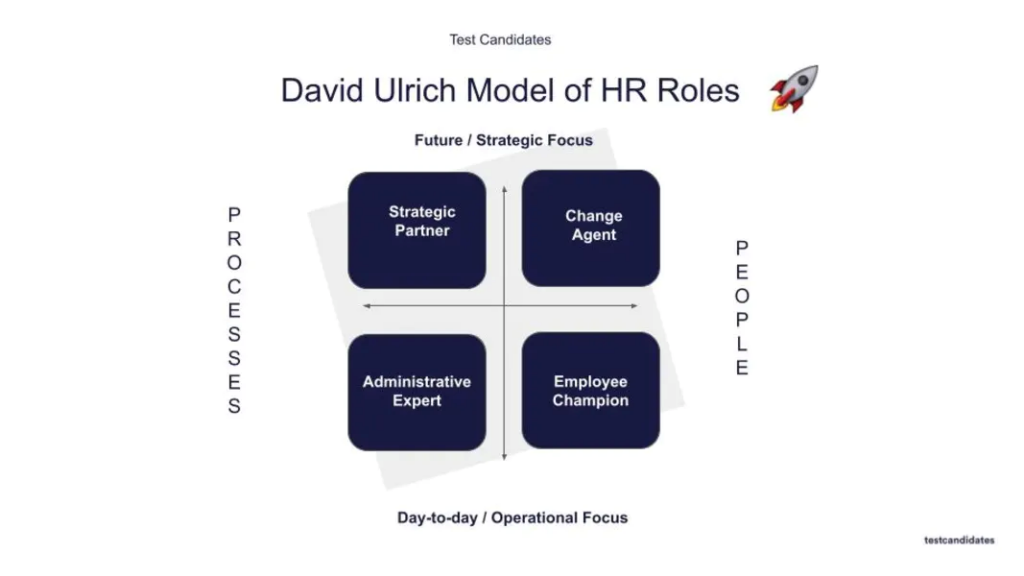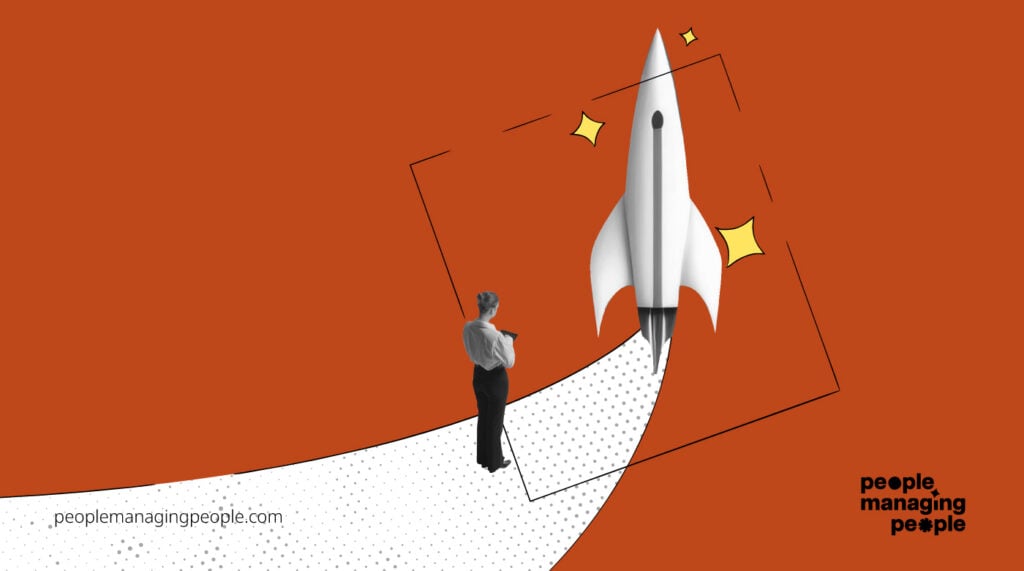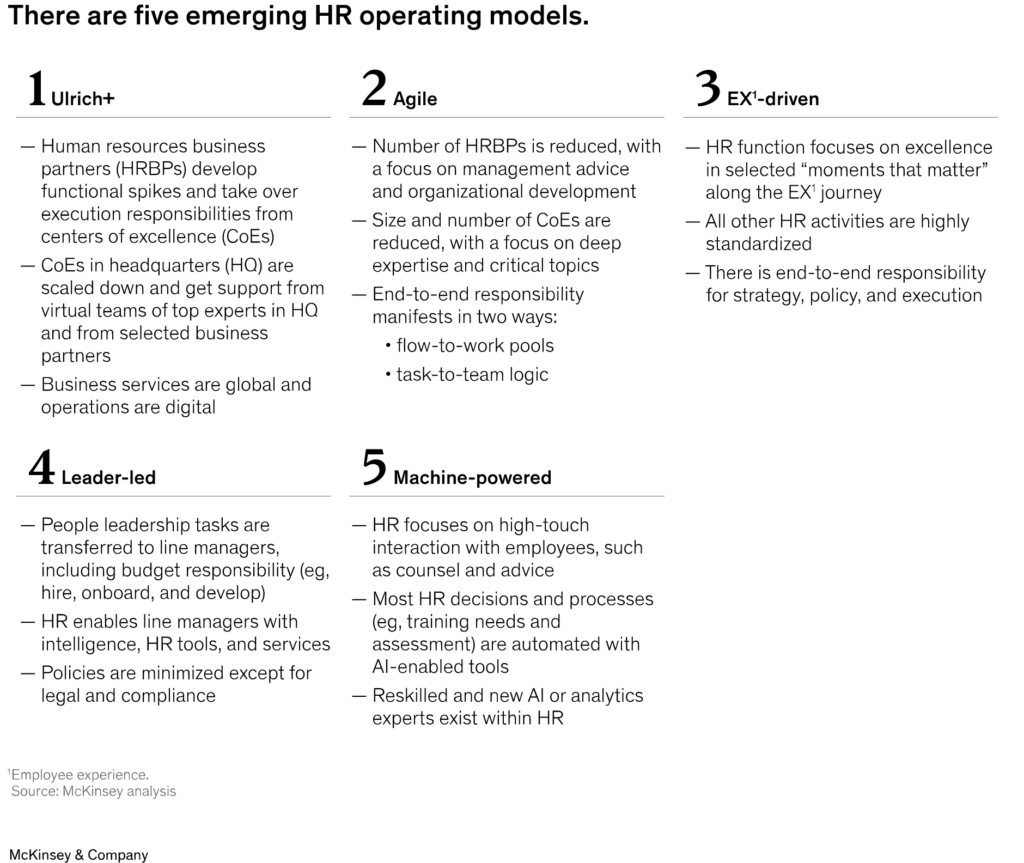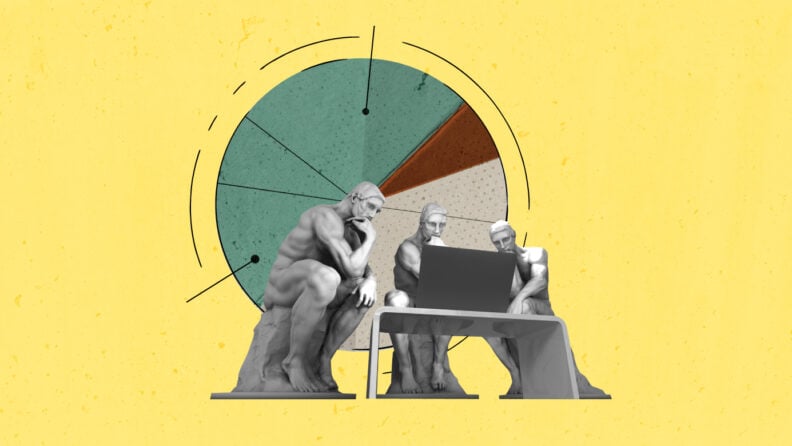As Bob Dylan once said, the times they are a-changin’ and it’s essential that, as HR professionals, we're proactively evolving our strategies to meet the rapidly changing needs of the modern workplace.
This also means updating our HR operating models so we can best design and implement the solutions required.
Keep reading to learn more about how HR operating models are evolving as organizations reimagine the function’s role in the future of work.
What Is An HR Operating Model?
An HR operating model is a framework that details how an organization's HR function will deliver the services that help enable the success of the rest of the organization.
The goal of an HR operating model is to ensure that human resources is aligned with the organization’s overall strategy and goals and can support the needs of the business as effectively and efficiently as possible.
Typically, this framework outlines the following:
- The structure and design of the HR team (including roles and approval hierarchies)
- The processes and systems that will be used to deliver HR services, and
- The HR metrics that will be used to measure the performance of the function.
An effective HR operating model is grounded in the business needs the human resources function seeks to address. It helps define the following:
- Which imperatives or outcomes HR is tasked with delivering:
- Workforce management (e.g. organizational design, talent management, succession planning, change management)
- Operational services (e.g. benefits administration), workforce development (e.g. learning programs and products)
- Driving productivity and engagement outcomes (e.g. initiatives targeting employee experience, cultural transformation, and DEI).
- Who is responsible for delivering these outcomes: strategic HR business partners (HRBPs), specialized centers of excellence/expertise (CoE), shared services centers (SSCs), project-based teams, HR technology—or a combination of all these elements.
- How these outcomes are delivered (and measured):
- Strategic organizational design
- Implementing innovation frameworks
- Adopting core guiding principles (e.g. teamwork, customer focus)
- Practicing goal-setting and road-mapping for key HR objectives
- Tracking HR key performance indicators (HR KPIs) and embracing data-driven decision-making.
Types Of HR Operating Models
No two organizations are the same and as such no two HR operating models will exactly mirror each other.
That being said, there are some common approaches to help HR teams decide how they operate and build their structure.
It’s worth noting that these aren’t set in stone and organizations may choose to mix and match models.
Here are 5 general models:
1. Business Partner Model
Pioneered by a former podcast guest of ours, Dave Ulrich, in the mid-90s, the business partner/Ulrich Model is a popular framework for structuring an organization’s HR function to improve efficiency and efficacy.
Particularly ubiquitous among large, customer-focused organizations, the original model splits the human resources function into four key roles:
- Strategic Partner: working closely with business leaders to understand the organization's strategy and goals and develop HR strategies that support them.
- Employee Champion: working to improve the overall employee experience and promoting a positive work environment.
Change Agent: leading or supporting change initiatives within the organization and helping to create a culture of continuous improvement.

In most traditional HR operating models based on the Ulrich Model, these four HR roles are typically translated into three roles that support the HR leadership team, namely human resources business partners (or HRBP), shared services centers (or SSCs), and centers of excellence (or COE).
HR Business Partner or HRBP
A human resources business partner (or HRBP) is an experienced HR professional who works closely with an organization's senior leadership and business units.
An HRBP functions as a strategic consultant rather than an HR service provider and serves to align HR strategies with overall business objectives.
Centers of Excellence (CoEs)
HR CoEs or centers of excellence are centralized subfunctions within an organization’s HR function that provide specialized expertise, guidance, and support in key HR disciplines. These include recruitment or talent acquisition, talent analytics, and learning and development.
The goal of a CoE is to drive best practices to improve HR’s critical capabilities and ensure that HR activities align with the organization's mission, values, and culture.
Shared Services Centres (SSCs)
An SSC is an IT-supported HR function that serves as a centralized point of service for multiple business units within an organization. It comprises the people, processes, and technologies needed to provide a range of HR services to employees, managers, and HR professionals.
The purpose of an HR SSC is to improve the efficiency and cost-effectiveness of HR processes by standardizing HR services, automating HR transactions, and reducing administrative workload. An HR SSC typically provides services such as payroll processing, employee benefits administration, HR information systems (HRIS) support, and employee self-service portals.
Limitations Of The HR Business Partner Model
While the HRBP model has endured largely unchallenged for decades, it’s proving to be ill-equipped to deal with the constantly changing needs of organizations in today’s disruptive business environment.
Some of its core limitations include the fact that most HR business partners simply don’t have the bandwidth to stay up-to-date with the latest developments in HR, and, crucially, COEs often aren’t flexible enough to be truly agile and reactive to change.
This is especially relevant given the way job roles, teams, and reporting structures are changing in agile organizations. Any given employee’s responsibilities may change significantly from day to day or month to month.
For example, it’s increasingly common for agile companies to use temporary, cross-functional teams to run innovation sprints to identify problems or opportunities and prototype (and test) solutions. These teams may form for a week, a quarter, or a year before the collaborators move on to different projects.
HR needs to find ways to accommodate this more horizontal way of working. To do that, it needs more flexible and agile HR operating models than the hierarchies and role architectures of the past—and the Ulrich Model—allow for.
2. Functional Model
The functional HR operating model is structured around specialized HR functions or departments, each focusing on a specific area of human resources management.
This model organizes the HR department into distinct units that are responsible for different HR activities, such as recruitment, learning and development, or compensation and benefits.
Each of these units operates as a center of expertise for its particular area, providing specialized services, guidance, and support to the rest of the organization.
Key characteristics of the functional HR operating model:
- Specialization: Each function within HR is staffed by experts with deep knowledge and skills in their specific domain. This allows for a high level of expertise and efficiency in managing HR processes and issues.
- Efficiency: By concentrating similar activities within specialized departments, the functional model can achieve economies of scale, standardizing processes and making efficient use of resources.
- Clarity of roles: The division of HR into distinct functions provides clear roles and responsibilities, making it easier to manage HR activities and accountability.
- Consistency: A functional structure can help ensure consistency in HR policies and practices across the organization, as each function develops its own set of standards and guidelines.
Limitations of the functional HR operating model:
- Silos: One of the challenges with the functional model is the potential for creating silos within HR, where departments operate in isolation from one another. This can lead to a lack of coordination and integration of HR activities across the organization.
- Flexibility: The specialized nature of each HR function may limit its flexibility in responding to changing organizational needs or emerging HR trends.
- Business alignment: There is a risk that HR functions become too inward-looking and disconnected from the broader business objectives and needs of the organization, focusing more on HR processes than on business outcomes.
3. Front-back Model
The Front-Back model shares characteristics with the HRBP model because it also uses business partners, shared services, and CoE.
This model divides the HR department into two main parts: the "Front" and the "Back."
Front office HR:
- Business-facing role: The front office of HR focuses on interacting directly with business leaders and employees. It is responsible for understanding the strategic needs of the business and ensuring that HR policies, programs, and services are aligned accordingly.
- HR business partners: Typically, this area includes HR Business Partners (HRBPs) who work closely with department heads and line managers to provide strategic HR guidance, support organizational design, talent management, and drive HR initiatives that support business objectives.
- Employee engagement and relations: The front office is also often responsible for employee engagement, initiatives to improve company culture, and handling complex employee relations issues, acting as the first point of contact for employees.
Back office HR:
- Operational and administrative role: The back office of HR focuses on the operational, administrative, and transactional activities of HR. This includes payroll, benefits administration, HR data management, and compliance with labor laws.
- Centers of excellence: Like the HRBP model, the back office may also include CoE for different HR specialties, such as compensation and benefits, learning and development, and talent acquisition.
- Shared services: For larger organizations, the back office might include a shared services center that handles routine HR transactions and inquiries from employees across the organization, leveraging technology and standardized processes for efficiency.
Key characteristics of the front-back model:
- Strategic alignment: By separating strategic and operational roles, the model allows the front office to focus on aligning HR initiatives with business strategies, while the back office ensures efficient execution of HR processes.
- Efficiency and expertise: The back office's focus on operational excellence and the front office's strategic alignment work together to ensure that HR services are delivered efficiently and effectively, leveraging expertise in each area.
- Flexibility and responsiveness: This model can enhance HR’s ability to respond to changing business needs by allowing the front office to act as a flexible partner to the business, adapting HR strategies as required, while the back office maintains stable and efficient operations.
Limitations of the front-back model:
- Integration and communication: Ensuring effective communication and coordination between the front and back offices is crucial to avoid silos and ensure that HR services are seamless and cohesive.
- Balancing strategic and operational demands: Finding the right balance between strategic initiatives and operational efficiency can be challenging, requiring clear roles, responsibilities, and expectations.
4. The Hub and Spoke Model
The hub and spoke model is a framework designed to combine centralized control with decentralized execution, facilitating both efficiency and flexibility in managing human resources across an organization.
This model is characterized by a central "Hub" that provides direction, policies, and strategic HR services, surrounded by "Spokes" that are tailored to the specific needs of different business units or geographic locations.
Hub:
- Centralized functions: The Hub includes the central HR team responsible for strategic planning, policy formulation, and oversight. It may also house centers of excellence for specialized HR functions.
- Standardization and control: The primary role of the Hub is to ensure consistency in HR practices across the organization, align HR strategies with the overall business strategy, and manage enterprise-wide HR initiatives and technologies.
Spokes:
- Localized HR teams: Spokes represent decentralized HR teams located within different business units, departments, or geographic regions. These teams are responsible for implementing and adapting HR practices to meet the specific needs of their respective areas.
- Flexibility and responsiveness: By being closer to the operations and employees they serve, Spoke teams can provide more tailored HR support, address local issues more effectively, and ensure that HR initiatives are relevant and responsive to the specific context of each part of the organization.
Key characteristics of the hub and spoke model:
- Balance between consistency and customization: This model strives to achieve a balance between maintaining consistent HR policies and practices across the organization (through the Hub) and allowing for customization and responsiveness to local needs (through the Spokes).
- Efficiency and expertise: The central Hub enables the organization to leverage economies of scale and build deep expertise in key HR areas, while the Spokes allow for agile and effective HR management closer to the ground.
- Strategic alignment and operational flexibility: The Hub focuses on strategic alignment with business objectives, while the Spokes focus on operational and tactical HR issues, ensuring that HR supports both the strategic and operational needs of the business.
Limitations of the hub and spoke model:
- Communication and coordination: Effective communication and coordination between the Hub and Spokes is critical to prevent silos, ensure alignment, and facilitate the sharing of best practices across the organization.
- Balancing central control with local autonomy: Finding the right level of central control versus local autonomy can be challenging, as too much centralization can stifle local innovation, while too much decentralization can lead to inconsistency and inefficiency.
5. Federated Model
The Federated HR Operating Model is a framework designed to balance the organization's need for centralized HR policies and practices with the autonomy of different business units or geographic regions.
It's a blend that combines elements of centralization and decentralization, allowing for both uniformity in strategic HR functions and flexibility in local implementation.
Key features of the federated HR operating model:
- Centralized strategy with decentralized execution: At its core, the federated model allows for the strategic aspects of HR (such as overarching policies, core values, strategic talent management) to be governed centrally, ensuring consistency and alignment with the organization's overall goals. Execution, however, is decentralized, with local HR teams having the autonomy to adapt and implement these strategies to fit their specific contexts and needs.
- Balance of power: This model is characterized by a careful balance of power and responsibility between the central HR function and the HR entities within individual business units or geographic regions. There's a shared responsibility for achieving HR and business objectives, with clear delineations of which aspects are centrally controlled and which are locally managed.
- Cross-functional and cross-regional collaboration: Federated HR models encourage collaboration across different parts of the organization. This might involve cross-functional teams working on specific projects or initiatives, sharing best practices, and leveraging knowledge across different regions and business units.
- Flexibility and responsiveness: By allowing local units to manage HR functions in a way that best suits their specific challenges and opportunities, the federated model provides the organization with greater flexibility and responsiveness to local market conditions and cultural nuances.
Characteristics of the federated model:
- Alignment with business strategy: Ensures that HR policies and practices are consistently aligned with the overarching goals of the organization, while still catering to local needs.
- Enhanced agility: The decentralized aspect allows for quicker responses to local challenges and opportunities, enhancing the organization's overall agility.
- Cultural sensitivity: Facilitates a more culturally sensitive approach to HR management, acknowledging and adapting to the diversity within the organization.
Limitations of the federal model:
- Complexity in coordination: Maintaining effective communication and coordination between the central HR function and local units can be challenging, potentially leading to inefficiencies or inconsistencies.
- Risk of fragmentation: There's a risk that the organization might become fragmented if local units diverge too far from central policies or if there's a lack of clarity around roles and responsibilities.

The Need For New Operating Models
Just about anyone working in human resources can attest to the fact that the role of HR has changed significantly in recent years.
As a result, the mandate of the HR function is shifting and evolving rapidly to keep pace with the changes in the world of work:
| From: | To: |
|---|---|
Spearheading workforce planning and recruitment. | Spearheading workforce planning and recruitment, with an increased focus on employer branding to attract and retain top talent. |
| Implementing one-size-fits-all benefits plans that meet the needs of most employees. | Reviewing and adjusting employee benefits to individuals’ actual needs and priorities. |
| Implementing HR software for administrative and record keeping purpose. | Implementing HR software to digitize, streamline, and automate workflows and harnessing workforce analytics to benchmark and improve HR KPIs. |
| Providing company-specific orientations to introduce new employees to company culture. | Facilitating employee onboarding processes that get new hires up to speed faster and more effectively. |
| Leveraging annual performance management processes to provide feedback to all colleagues around progress against goals. | Testing new, more effective performance management methodologies to better recognize achievement, develop potential, and match top performers to critical roles. |
| Providing a broad selection of employee wellbeing resources to meet the needs of as many employees as possible. | Delivering an outstanding employee experience that promotes employee health and wellbeing and combats workplace burnout. |
| Empowering colleagues to ‘own their own development’ and giving them a broad base of resources to support. | Driving effective succession planning at scale, promoting internal mobility, and developing leaders that inspire employees to do their best work. |
| Leveraging annual engagement surveys to collect employee feedback and empower teams to drive their own changes. | Taking intentional efforts to impact employee retention and boosting employee engagement levels. |
| Creating role-specific learning and development programs. | Cultivating a culture of learning that facilitates career growth and implementing learning and development programs to bridge skills gaps. |
Leveraging employee resource groups to empower employees to create more inclusive work environments. | Actively fostering an inclusive and psychologically safe organizational culture that emphasizes diversity, equity, and inclusion in the workplace. |
As the mandate of the HR function continues to evolve, there is a clear need for new operating models that empower HR professionals with the strategy, resources, and flexibility to ideate solutions that create new value by balancing the organization’s priorities with those of its people.
Operating Models For The Future of HR
HR transformation or evolution is unavoidable for organizations that want to remain competitive in the future of work.
A recent study found that more than 90% of chief human resources officers (CHROs) in the United States and Europe expect significant changes to the HR operating model within the next two to three years.
As HR grapples with its changing role and digital transformation, various new HR operating models are emerging.
Some of the factors these new operating models have in common include:
- An awareness of the growing need for agility and adaptability
- An increased focus on the employee experience
- The use of tech like workflow automation software and data analysis to augment HR’s capabilities.
But what does that look like, practically? How can we set up HR to enable businesses to deliver excellent end-to-end employee experiences?
Well, it depends on the business strategy HR is enabling and the size of your org.
Gartner argues that creating a flexible and effective HR operating model will necessitate four key changes:
- Dividing the HRBP role into more specialized roles
- Curating a pool of dynamic HR problem solvers
- Implementing next-gen COE to provide agile support
- Developing a robust HR service delivery and operations team
McKinsey has identified eight innovation shifts driving five operating model archetypes, namely Ulrich+, Agile, EX-driven, Leader-led, and Machine-powered. The image below provides a summary of these operating models.

Selecting The Right HR Operating Model
Every organization is different, so it stands to reason that each organization’s best-fit operating model will depend on its specific context, business model, strategic priorities, and operational needs.
Some factors that influence which operating model is the best fit include
- Business strategy, organizational goals, and needs. A company’s stage of growth and broader strategic direction should go hand-in-hand with its HR strategy. The HR operating model should serve to answer both long-term and immediate organizational needs, whether it’s improving employee retention, acquiring top talent, upskilling/reskilling existing talent, or managing change. This is your north star!
- Size and organizational structure. A business with a one-person HR team will naturally have different operational needs than an enterprise with a large HR department and multiple HR managers. For example, a large enterprise with an established reputation or culture may need to weigh the need for consistency/homogeneity throughout the organization’s various branches against the benefits of more flexible (and agile) operating models.
- Geographic reach. Whether a company operates in a single geographic region, nationally, or internationally, will impact its HR needs. For instance, more geographically-dispersed organizations will likely prefer a decentralized operating model with localized hubs over a more centralized operating model.
- Workplace/workforce model. Companies with remote or hybrid workforces will have different HR operational requirements, e.g. a greater reliance on HR technology such as employee self-service portals.
- HR tech stack. An organization’s human resources information system (HRIS) and the capabilities of the tool(s) it uses can have an enormous impact on the way its HR function operates. For instance, many HRIS solutions can significantly improve HR’s efficiency and productivity by automating administrative processes. However, transitioning to a new HRIS can be a huge challenge in itself for some organizations with deeply entrenched HR software.
Some organizations may find that the best approach for them is to adopt a combination of multiple different operating models.
For instance, a multinational organization might transition its Ulrich-based shared services centers with a version incorporating virtual global business services while retaining certain specialized (or localized) centers of excellence.
Transitioning To A New HR Operating Model
For many companies, making the change to a new operating model can be a daunting prospect.
For those organizations, it’s important to acknowledge that transitioning to a new model doesn’t have to mean a wholesale overhaul or instantaneous system redesign.
It can also be tempting to think that throwing the right tech at the problem will fix everything.
However, without a thoughtful analysis of the organization’s existing systems, employees’ needs, current HR shortfalls, and the role HR is to play in making the business’ strategic vision a reality—not to mention careful implementation and change management—even the most cutting edge HR technology will only be a stop-gap measure.
Here are some best practices for effectively transitioning to a new HR operating model:
- Engage stakeholders from across the organization
- Give front-line HR a seat at the strategic “table” to align HR and business priorities
- Assess critical capabilities and identify areas for capacity-building
- Actively listen to employees to understand their needs and priorities
- Identify gaps and opportunities for incremental improvements
- Run sprints with cross-functional teams for a broader perspective
- Create an enablement roadmap with small, achievable milestones
- Adopt an agile mindset of implementing, testing, and iterating before launching at scale
- Measure the impact of changes through quantitative and qualitative data analysis and continue to make tweaks and fine-tune your operating model.



